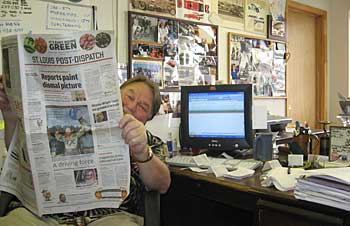Racing Net Source LLC
114 E. Elm St. , Ste. 8O'Fallon, MO 63366-2642
636.272.6301 / fax 636.272.0412

DRAG RACING Online will be published on the 8th of each month and will be updated throughout the month.
DRAG RACING Online owes allegiance to no sanctioning body and will call 'em as we see 'em. We strive for truth,integrity, irreverence and the betterment of drag racing. We have no agenda other than providing the drag racing public with unbiased information and view points they can't get in any other drag racing publication.
EDITORIAL |
|
Editor & Publisher, CEO |
Jeff Burk |
Managing Editor, COO |
Kay Burk |
Editor at Large |
Bret Kepner |
Editor at Large, Emeritus |
Chris Martin |
Bracket Racing Editor |
Jok Nicholson |
Nostalgia Editor |
Jeff Utterback |
Contributing Writers |
Jim Baker, Darr Hawthorne, |
Australian Correspondent |
Jon Van Daal |
European Correspondent |
Ivan Sansom |
Poet Laureate |
Bob Fisher |
Cartoonists |
Jeff DeGrandis Kenny Youngblood |
PHOTOGRAPHY |
|
Senior Photographer |
Ron Lewis |
Contributing Photographers |
|
PRODUCTION |
|
Creative Director/ Webmaster |
Matt Schramel |
Production Assistant |
Clifford Tunnell |
Site Programmer/ IT Consultant |
Adrienne Travis |
ADVERTISING |
|
| Director of Sales | Darr Hawthorne 818-424-6656 |
FINANCIAL |
|
| Accounts Manager, Chief Financial Officer | Casey Araiza |
- Agent 1320
- At the Back Door (caption contest)
- Letter to the Editor (for publication)
- New product press releases

© 2006-2020, Drag Racing Online
and Racing Net Source LLC

Just Wondering: Speed, is that all there is?
 Just Wondering … Why, after almost five years, we still haven’t got the promised report from the NHRA on Darrell Russell’s crash or, after 15 months, no official statement about Eric Medlen’s crash, but just a week after Scott Kalitta’s death we get a full report from the NHRA on the possible problems and their course of action? Could the New Jersey State Police investigation have anything to do with it?
Just Wondering … Why, after almost five years, we still haven’t got the promised report from the NHRA on Darrell Russell’s crash or, after 15 months, no official statement about Eric Medlen’s crash, but just a week after Scott Kalitta’s death we get a full report from the NHRA on the possible problems and their course of action? Could the New Jersey State Police investigation have anything to do with it?
Just Wondering … Was I the only one who noticed that the average speeds of the fuel cars at Norwalk were way off the pace that we are used to seeing? The Top Speed for Funny Cars was a 309 and the Top Speed for Top Fuel was a 320! Three hundred-mph passes were hard to come by. I hear the racers blamed it on a “green” track. So, not prepping the tracks so much slows the speeds down? Now there’s something I never thought of.
Just Wondering … How can the NHRA racers who went on TV after the Scott Kalitta crash and took the track and NHRA to task, railing about safety issues, then went out the next morning and got into the same cars on the same track and put themselves in the same peril, expect their safety concerns to be effective with the sanctioning body management?
Just Wondering … Does it strike anyone else as being strange that the NHRA seems to depend on their racers to tell or show them how to solve the problems regarding safety and other matters while hiring folks with titles and big salaries to do those jobs?
Just Wondering … Even without a sponsor for the Top Fuel Shootout this year couldn’t the NHRA management have spent some of the money they spent to hire expensive new management and public relations firms, build new towers, install premium seating or VIP suites to fund the Top Fuel Shootout program? For many Top Fuel teams making that program was a big deal for them and their existing or potential sponsors. When faced with basically a similar situation the IHRA showed a lot of class and business sense by funding their programs out of their own pockets, which is the right thing to do for the stars of your show.
Just Wondering … How many fans and racers know that the guidelines for building NHRA dragstrips in the modern era specify that the shut-off area has to be just a half-mile? Calls to track management for half a dozen NHRA tracks verify that. The exception to that is that many of the older national event tracks are shorter; the shortest being Pomona which, according to one group who studies all NHRA tracks, has only 2100 feet of shutoff, followed by Norwalk and E-town which reportedly have about 2500 feet.
Just Wondering … Has everyone forgotten that the speeds that come up on the boards is not the actual Top Speed but just the average speed the car was traveling between 1260 feet and 1320 feet? That means that a car that is driven under a full throttle “out the back door” is going much faster than the number the fans see. Tuners tell me that the front wheel speed sensors they all have as part of their data logger system have shown speeds of 345 mph and higher!
Just Wondering … Did you know that at 335 mph a drag car is moving at the rate of 491.33 feet per second and at 300 mph the rate is 439.99 fps? Now imagine yourself trying to stop a race car that weighs almost 2600 lbs in just 3,000 feet. Then try thinking about doing that without functioning brakes or chutes or both in a burning car. That’s not an indicator of how dangerous racing a nitro burning fuel car is, that’s how dangerous it can be just getting it stopped after the race is over.
Just Wondering … Is speed the real attraction for drag fans or is it which car gets to the finish line first? Or has the sport just turned into a carnival act where the racing is secondary to the smoke, noise or occasional engine explosion or crash? I’m not saying, I’m just wondering.
Just Wondering … In view of the rapidly rising cost of nitro wouldn’t it make financial and common sense to make engine/fuel delivery rules that would both reduce the amount of nitro a team will use during a race weekend and the performance?
Just Wondering … Why the NHRA insists on sticking with the rev-limiter?
Their original intent for mandating the device was to help control speed, reduce engine explosions and allegedly save the teams money. Restricting speed and ET was accomplished, but fewer explosions and saving money? I don’t think so.
Just Wondering … Where does NHRA president Tom Compton stand on making NHRA drag racing safer, the cost of fielding a professional race team, the death of Scott Kalitta, and the future of drag racing? While his peers in the racing industry such as NASCAR’s Mike Helton and the IRL’s Tony George are readily accessible and visible, Compton rarely speaks out regarding NHRA policy or addresses its problems. Is it any wonder that many fans and racers think that the person most seen delivering the company policy on TV or to the press, Graham Light, is running the NHRA?
Just Wondering … In view of the rash of bad accidents in the NHRA nitro class in the last 15 months, will the IHRA start requiring all of the NHRA rules for their nitro classes? Currently IHRA-legal Top Fuel or Funny Car wouldn’t pass NHRA tech as the IHRA hasn’t adopted NHRA chassis or weight rules yet.
Just Wondering … Is the disqualification of two funny car teams at Norwalk an indication that the NHRA tech department, who have always been known for their thoroughness (I’ve been to the “barn” once), are now being even more diligent in their job and allowing zero tolerance. If so, kudos to them.
Just Wondering … Why the electronic media jumped on Gary Scelzi and Melanie Troxel’s case, virtually assigning them the blame for the loose weight being in the cars at the scales that resulted in the Funny Car teams being DQ’d at Norwalk? Shouldn’t the blame have gone to the crew chiefs? How about interviewing those crew chiefs instead of the drivers?
Just Wondering … Nitro cars going over 330 mph, safety rules that make the cars weigh more than they have at anytime in recent memory, and tracks where the normal shutdown area is nominally a half mile. Is anyone surprised that stopping these cars in that distance doesn’t leave much margin for error?
Just Wondering … Have the NHRA and the racers painted themselves into a corner as far as safety and performance is concerned? Over the past few years in order to make the cars safer for the driver NHRA has mandated for the cars and drivers (at the urging of myself and others) additional safety items and made others heavy-duty (heavier), the teams have added more go-fast parts like dual mags, dual fuel pumps, timers, data loggers, sensors, and the list goes on. At the same time NHRA mandated rev-limiters, a part some tuners think can cause engine explosions, and reduction of nitro percentage. As a result of a heavier car and less nitro in the tank tuners have to “lean” on their engines to make more power just to maintain the 60-foot performance they had before the changes. One result of that might be engines not just throwing the rods out and having a little fire but massive explosions that shred the body and send the back wheels three feet off the ground such as those seen from the Pedregon brothers and Scott Kalitta. At the same time the added weight makes the cars harder to stop. Someone at NHRA has to make the call to change the program before another bad crash or death.

Recent Stories
- Burk's Blast - NHRA drag racing's history and tradition is not measured in feet![7/3/2008]
- Burk's Blast – NHRA drag racing’s history and tradition is not measured in feet![7/3/2008]
- Burk's Blast - So many questions for the NHRA and IHRA[6/17/2008]
- Burk's Blast - What the hell is going on?[6/10/2008]
- Burk's Blast - Still Wondering[6/2/08]